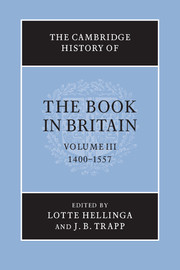Book contents
- Frontmatter
- Introduction
- 1 Literacy, books and readers
- TECHNIQUE AND TRADE
- COLLECTIONS AND OWNERSHIP
- 9 Private ownership of printed books
- 10 Monastic libraries: 1400–1557
- 11 The early royal collections and the Royal Library to 1461
- 12 The Royal Library from Edward IV to Henry VII
- 13 The Royal Library under Henry VIII
- READING AND USE OF BOOKS
- Appendix
- List of abbreviations
- Bibliography
- Photo credits
- General index
- Index of manuscripts
- Bibliographic index of printed books
- Plate Section"
- References
13 - The Royal Library under Henry VIII
from COLLECTIONS AND OWNERSHIP
Published online by Cambridge University Press: 28 March 2008
- Frontmatter
- Introduction
- 1 Literacy, books and readers
- TECHNIQUE AND TRADE
- COLLECTIONS AND OWNERSHIP
- 9 Private ownership of printed books
- 10 Monastic libraries: 1400–1557
- 11 The early royal collections and the Royal Library to 1461
- 12 The Royal Library from Edward IV to Henry VII
- 13 The Royal Library under Henry VIII
- READING AND USE OF BOOKS
- Appendix
- List of abbreviations
- Bibliography
- Photo credits
- General index
- Index of manuscripts
- Bibliographic index of printed books
- Plate Section"
- References
Summary
At one time or another, Henry VIII owned more than fifty palaces, each presumably with its own collection of books. Books seem to have been moved from one library to another and it is not possible to divide the various collections rigidly by function. In the first decades of the sixteenth century, however, as earlier, the main collection was housed at Richmond, which had been rebuilt after Sheen was destroyed by fire in 1497. During the reign of Henry VII, Quentin Poulet had been granted an annual salary of 10 marks for keeping the King’s Library, though Poulet would have been employed principally as scribe and illuminator (see figs. 12.2 and 12.3). In the first year of Henry VIII’s reign, Giles Duwes was described as Keeper of the King’s Library at Richmond, with an annuity of £10, and, in 1534, William Tyldesley was designated Keeper of the King’s library ‘in the manor of Richmond and elsewhere’, also at £10 per year. In February 1535, a French visitor, possibly Palamède Gontier, Treasurer of Brittany, drew up a list of 143 titles in the library at Richmond, almost all of which were in French, and many of which were large and elegant manuscripts of Burgundian-Netherlandish taste, prepared for Edward IV. This list, which seems to cover the whole contents of the library, suggests that the Richmond collection was a personal one built up by successive monarchs, rather than an institutional repository.
- Type
- Chapter
- Information
- The Cambridge History of the Book in Britain , pp. 274 - 282Publisher: Cambridge University PressPrint publication year: 1999
References
- 1
- Cited by



